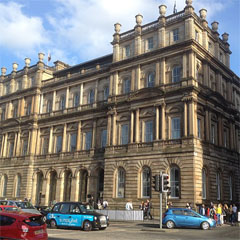India and Edinburgh: The New Town
 |
1. The Scottish Naval and Military Academy The Scottish Naval and Military Academy, founded 1825, trained young gentlemen for the British and East India Company’s forces,. Read more… |
 |
2. St John’s Episcopal Church In 1818 the growing episcopal congregation of Charlotte Chapel, Rose Street, built a new church, St John’s, on the corner of Lothian Road/Princes Street. Read more… |
 |
3. Melville Street The first written mention of curry being eaten in Edinburgh is found in the memoirs of Bombay-born Janet Maughan. Read more… |
 |
4. Census on Randolph Cliff This randomly-selected block of buildings, without obvious India connections, is a good example of India links visible in census returns. Read more… |
 |
5. Charlotte Square Charlotte Square has seen colourful India links. No. 22 was home to Lady Gordon and her granddaughter Jane Cumming, described as a “Dark skinned girl, a native of India” in an 1810 trial. Read more… |
 |
6. 45 George Street William Blackwood & Sons, an Edinburgh publisher and bookseller, was based here at 45 George Street 1829-1972. Read more… |
 |
7. The Royal Society of Edinburgh The RSE, created in 1783 for “the advancement of learning and useful knowledge” moved into this building in 1909. Read more… |
 |
8. Standard Life Rugby fans know the Calcutta Cup, originally gifted to a Calcutta rugby club by Standard Life, an example of Edinburgh business’ India involvement. Read more… |
 |
9. Melville Monument Although not erected for his India involvement, the Melville Column commemorates Henry Dundas, Viscount Melville (1742-1811), long resident at No 5 George Square. Read more… |
 |
10. Wellington Statue This major traffic intersection provided access to armed forces offices in Register House, and was an important area for ‘old India hands’. Read more… |
 |
11. Portuguese Canon on Calton Hill The ‘Portuguese Cannon’ tells several chapters of European expansion. Read more… |
 |
12. Royal High School, Regent Road The dominant secondary school in Edinburgh until 1824, the Royal High School’s list of former pupils engaging with India is too long to recount. Read more… |
 |
13. Burns Monument, Regent Road The idea to erect a monument to Burns was first proposed by John Forbes-Mitchell of Thainstone, Aberdeen, in Bombay in 1812. Read more… |
 |
14. Former Forsyth’s ‘Foreign & Colonial’ outfitters ‘Foreign and Colonial Outfitters’ a sign on the former Forsyth’s store speaks of Edinburgh’s Indian retail trade. Read more… |
 |
15. Scott Monument, Princes Street In 1821, Scott wrote: India is ‘the corn chest for Scotland, where we poor gentry must send our youngest sons as we send our black cattle to the South’. Read more… |
 |
16. Scottish National Gallery The Gallery does not have an ‘India’ category in its collection, but over the last 120 years, over 600 India-related objects have been acquired. Read more… |
